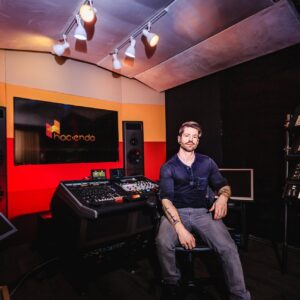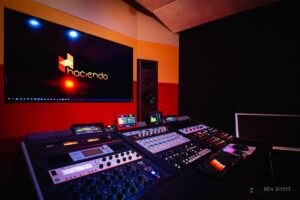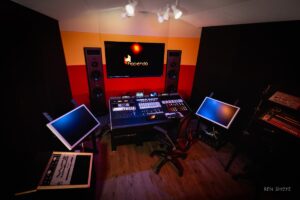One of the hardest things for any engineer or producer to get right isn’t the mix, its not even the music… it is the acoustics of the room they are sitting in. It’s a no brainer that this is one of the most important and crucial aspects of knowing what you are hearing and in return; engineering and producing with confidence in your work and decisions. So, we are happy to bring in a pro-topnotch-acoustics engineer (and well-known mastering engineer) Matt Davis of Hacienda Mastering to talk about all things Acoustics, for big and small studio spaces!
First off, a little about Matt Davis before we dive into the deep! Matt Davis is the founder of Hacienda. He is a graduate of both University of Miami’s Music Engineering undergraduate program and NYU’s Music Technology masters program. Over the course of a decade, Matt has had the privilege of mastering music for hundreds of artists and labels of varying genres, styles, and acclaim. He has trained under grammy winning mastering engineers, notably Bob Katz of Digital Domain.
Matt is currently an educator in the Recording Arts program at Full Sail University, and has been employed as a professor in audio programs at several other accredited US colleges.
Outside of engineering, Matt is a prolific electronic musician with releases covering many genres on several labels under different monikers. And his passion for acoustics has brought him around the USA to install acoustics into studios; both big and small!
Let’s get started with Going Deep in Acoustics with Matt Davis!

BOS – So, let’s start with a bit of background. What got you into Acoustic Treatment?
Matt – The real jump off point for acoustics was buying my first pair of PMCs a few years back, and feeling inspired and driven to optimize my playback environment in order to do them justice. My friend and mentor, Bob Katz, was teaching me the fundaments of room analysis and DSP alignment which I found fascinating, and I began digging into applied acoustics. I was moving into my current studio at the time and thought that social media might appreciate me documenting my design and build in detail and with ‘on site’ data. That series of posts got quite a bit of traction and sent the first few clients my way, they have since then recommended me to their friends and the demand for my firm has been growing ever since.
BOS – How long have you been Mastering and doing Acoustic treatments?
Matt – My interest in mastering started at NYU in 2009. I was fortunate enough to have enrolled in a course taught by Alan Silverman and the way he described the discipline resonated with me immediately. I’d been doing a ton of tracking/production/mixing before then, but the process of mastering really spoke to me. I’ve been actively developing the skillset since then and started offering it as a service in 2010. Acoustics is much more recent of a development for me, I started taking clients in 2017 shortly after the first phase build of my current studio was complete.
BOS – Why is it important to have a good room and acoustics, even for smaller rooms and studios?
Matt – I don’t think most people appreciate how much easier the process is when you’re starting with a trustworthy reference point. I spent years flying blind as a producer, aligning my systems by ear to an abstract and uncertain subjective target, using multiple monitoring systems which prompted more confusion than clarification, and having to religiously check my work on a variety of playback systems to vet the choices I was making in the studio. The more variables that can be controlled for in their playback environment the more authority one will have in making informed engineering decisions. It is incredibly empowering to have a sound system really working in congress with the room that contains it and not needing second opinions for translation as a result of that. The reduction of temporal masking which comes with getting a room’s RT60 into spec as part of the design process makes for a much more revealing playback experience which results in lower monitoring levels, less fatigue, and greater contrast of mix issues, making for faster work and less fishing around to find the issues. Having modal issues reigned in through applied acoustics and an appropriate house curve tailored to the preferences of the engineer makes the process of balancing low end to upper spectra and tailoring the decay of bass instruments more consistently accurate regardless of the key of the program material. Being in spec also lowers the delta in translation to other sound systems, which greatly improves the odds of creating a mix/master that translates to the widest variety of playback systems. Lastly, having a tightly controlled reflection free zone around the mix position yields much greater localization of sound sources in the stereo image for more accurate representation of panning and improved ambience decoding to make sound-staging decisions with a greater degree of precision and confidence.

BOS – If someone doesn’t have access to an acoustics engineer or being able to treat their room, are they better off just using Headphones?
Matt – I’ve heard some really nice mixes and masters being done on good headphones lately, and I would certainly prefer working with accurate playback through a revealing pair of headphones over working on mains in an untreated room. There are some great DSP tools coming out which blur the line between the presentation of monitors and headphones which I think have a good degree of utility in cases when a properly aligned sound system is unavailable. I exclusively work on my mains, even for QC work, but that is as a result of a great deal of investment in a room which is revealing enough for that task, the scope of which is far beyond something that could be done in a rental situation, for instance.
BOS – How does a professional such as yourself, check the room ‘mode’ and apply the acoustic treatment? What gear is needed?
Matt – We are in a golden era of acoustics analysis, thanks in large part to the tireless efforts of John Mulcahy at Room EQ Wizard. For anyone not familiar, Room EQ Wizard is a free suite of analysis/modeling/filter design modules that rivals anything else out there, a real gift to the DIY and professional acoustics communities. A copy of REW and a decent measurement mic is all you need to get started on room analysis. A decent mic will put you back between $100-$400. Room simulations can be done within REW to relate the issues you’re seeing in the frequency response plot to physical phenomena in the room itself and predict the results of added absorption to individual walls, as well as the impact of moving the mix/speaker positions around.
BOS – Is it OK for people to go online and read “how-to” on acoustic treatment and get by with a better room, or does this cause more harm than good without a professional there to help?
Matt – Sure, it worked out pretty well for me. Although my firm generates revenue from clients trusting us with design work and implementation, I come from deeply DIY roots and have a passion for empowering other DIY’ers. In the coming months we will be creating web content specifically for the purpose of educating producers/engineers working in home studio spaces on optimizing their less than ideal rooms. My intention in the near future is to build a series of test rooms which use common residential dimensions and wall compositions and comparing design methodologies in situ to search for the most optimal and economic design implementations in residential scenarios. It is my belief that the data generated and publicized will be useful to a broad cross-section of the home studio community who are working in similar conditions to our test environments.
BOS – What are different ways to treat a room with acoustic treatment?
Matt – The goals of any listening room are consistent regardless of how odd a given space may be. Those goals are modal control, early reflection control, and optimization of the time domain characteristics of the space. There are many tools available to meet these goals which are more or less applicable in different scenarios. You will find in most forums that you may get different answers to a given question from different acousticians, and I believe this largely to be driven by their integration into larger questions of design methodology. There are many routes to the destination of optimized sonics, and the efficacy of the overall system is the sum of those components working in conjunction with each other to meet spec. Some acousticians rely heavily on pressure traps, others work exclusively with velocity trapping, many use both to varying degrees. Some use a two stage approach of over trapping for modal/RFZ control and utilization of extra diffusion to get back into RT60 spec after the fact, others take a more minimal approach, others use a series of narrowband elements with carefully selected crossovers to avoid overtrapping in the first place. The important part is the destination more so than the sum of components that get you there, but the available toolkit of options is large in acoustics and create a fortuitous opportunity to impart an acoustician’s particular style on a design.

BOS – How can up-n-coming producers with small rooms and small setups increase their listening position and quality of playback? Can they do anything by themselves to make it better?
Matt – Absolutely, get some analysis software and start trying stuff. There is more latitude in manipulating frequency and phase domain response via moving speaker and mix positions around that just about anything else within the scope of small room acoustics. Picking the right spots for your speakers and yourself will carry you very far, even in an undertreated space. I recommend people start with their mix position 38% of the way from their front wall to their rear wall. Take a measurement, what is your low end doing, is it above the center of gravity for the rest of the frequency response or below it? Moving your speakers closer to their nearest rigid boundary (the front wall) will act as a boosting shelf below the baffle step frequency of your speakers, moving it further away from the front wall will act as a cutting shelf. Once you have that balance established then start experimenting with your mix position location. Try a foot forward, try a foot back, which one looks nicer? Go with that one. Which wall did you choose to be your front wall, what is the composition of that wall? What about the side walls, are they interior walls or exterior walls? A very unfortunate and common scenario in home studios is a mix of interior and exterior walls. If you have an interior side wall and an exterior side wall those boundaries will behave differently than each other as a result of their varying mass and rigidity. You can think of a boundary as a highpass filter to sound, the more rigid and massive the boundary, the lower the center frequency of that highpass and the more energy kept in the room. The ramifications of this are that different amounts of low frequencies are being “absorbed” by being allowed to pass through the wall, and also being re-radiated out of phase back into the room through tympanic resonance of flimsy drywall sheets with no insulation in the cavity to dampen the resonance. By mixing and matching these on your sidewalls you will have variance in sound pressure at the boundaries, resulting in asymmetrical frequency/phase responses which result in worsened stereo imaging. The best case scenario for a room with a good dimensional ratio is to also have “ideal” massive/rigid boundaries on all walls, as these are predictable in simulation and create good modal support which in turn yields good subrange presentation. Whenever possible try to set your front wall such that your sidewalls are both either interior or exterior as it will improve your imaging strength. I’ve had very good luck in rooms with rigid front and sidewalls with a flimsier back wall. The massive front wall helps acoustic loading of the low end into the room, the uniform sidewalls provide symmetry, and the “leaky” backwall permits deep subrange energy to leak out of the back of the room, requiring less deep trapping to reign it in. Beyond that just start buying fiberglass and sticking it on your walls. This is obviously a gross oversimplification of applied acoustics, but it is very hard to do worse for sonics than untreated drywall.
BOS – With your Mastering Studio, what all did it take to get it to sound as it needed to, in order to do high end Mastering?
Matt – Years of blood, sweat, and tears. My room didn’t play nicely at first, and I developed most of my skillset in applied acoustics through trying things and revising things that didn’t work. There were several iterations of sidewall trapping revisions with different insulation types and depths, most notably in the reflection free zone to make my PMCs play as nicely as possible in a room that is a little too narrow for farfield monitors. The front wall has been redesigned three times, landing most recently on my waveguided softflush implementation. The core of the cloud and soffit area treatment has been modified several times as well. I’m actually about to integrate some membrane traps above my clouds to reign in the last trace of modal ringing in the room, a little 60hz from the fundamental height mode. The room is unique in that it has served me both as a mastering room and an R&D space. This obviously makes for logistical issues in terms of downtime for my mastering clients, but we work very quickly in acoustics revisions to ensure their deadlines are met.
BOS – What is the most important thing about anyone’s production space? Is it the gear? The ear? The room? Or a combination thereof?
Matt – Again, the most important aspect is the sum of parts. I’ve worked around pretty compromised playback environments in the past and although it wasn’t fun I somehow managed to come up with mostly agreeable results, the process just was a lot slower. This impacts the pacing and momentum of the session, for some people this can be worked around, for others it will be a deal breaker. I personally believe the monitoring environment is of paramount importance to the process, but everyone’s process is a little different. I encourage everyone to try a session in a controlled listening room to see how the other side lives, it may be eye opening. I enjoy inviting my mastering clients to come audition their mixes in my room as it gives them a center of gravity to take home with them and inform their mixing decisions. The truth can be very surprising to them at times and often results in better mixes after the fact.

BOS – Are there any tips and tricks that you can give the readers to help them further in their career?
Matt – Stay objective, keep yourself honest, A/B everything you do, compare your new work with old work, gracefully accept constructive criticism from people whose work you respect. Most importantly be patient with yourself, this was far from an overnight success for me and I’m glad I stuck it out.
BOS – What do you love about the music industry?
Matt – So, I’m actually pretty anti-industry. I started my own outfit in an effort to stay independent from outside influence and most of my foundation of practical knowledge was self-taught via trial and error. I don’t seek out major labels nor high-profile artist clients. My goal with the mastering house was to create a world class facility focused on independent labels/artists who I prefer working with and whose work I personally respect. I enjoy the autonomy that working in underground scenes affords me and am not really interested in working any other way.
BOS – What do you hate about the music industry?
Matt – The design by committee tendencies are particularly annoying to me. The involvement of a team of specialists should afford a degree of independent control to the contributors in the production process, but I find that to be less the case the further you lean into the industry at large. All professional relationships should be grounded in mutual trust and the erosion of those boundaries of respect are something I see as being kind of misguided. Also, they all want their masters too damn loud, and I’m not interested in indulging that.
